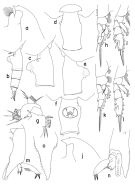
issued from : T. Park
in Bull. Scripps Inst. Oceanogr. Univ. California, San Diego, 1995, 29. [p.146, Fig.36].
Female: a, forehead (left side); b, urosome (left); c, d, e, f, genital somite (left, dorsal, right, ventral, respectively); g, Mx1 (first inner lobe omitted), posterior; h, P1 (anterior); i, P2 (anterior).
Nota: Similar in habitus to
P. paraprudens but readily distinguishable from it and other related species.
Laterally, rostrum triangular with straight anterior and somewhat convex posterior margin.
Dorsal wall of genital somite with broad swelling just anterior to middle. Ventral margin of genital flange nearly straight, sloping in a posteroventral direction. Posterior edge of genital field produced into a relatively small lobe. A minor indentation marking where posterior margin of genital prominence meets posterior ventral wall of somite, but together they form a broad arc. Two tubercular outgrowths on left side of genital somite close to ventral wall anterior to genital prominence. The posterior one of the outgrowths has several ridges. Dorsally, genital somite with wavy lateral margins anterior to genital swelling.
2nd urosomal somite in lateral view with a low dorsal hump close to proximal end.
Cephalosomal appendages including Mx1 as in
P. malayensis but seta on 2nd exopodal segment of A2 very small.
In P1 exopod, outer spine of 1st segment very small; that of 2nd segment a little short of reaching base of following outer spine.
Male: j, forehead (left); k, P1 (anterior); l, P2 (anterior); m, distal exopodal segments of left 5th leg (anterior, tiltedcounterclockwise); n, idem (medial); o, serrated lamella of left 5th leg exopod (anterior, tilted counterclockwise).




